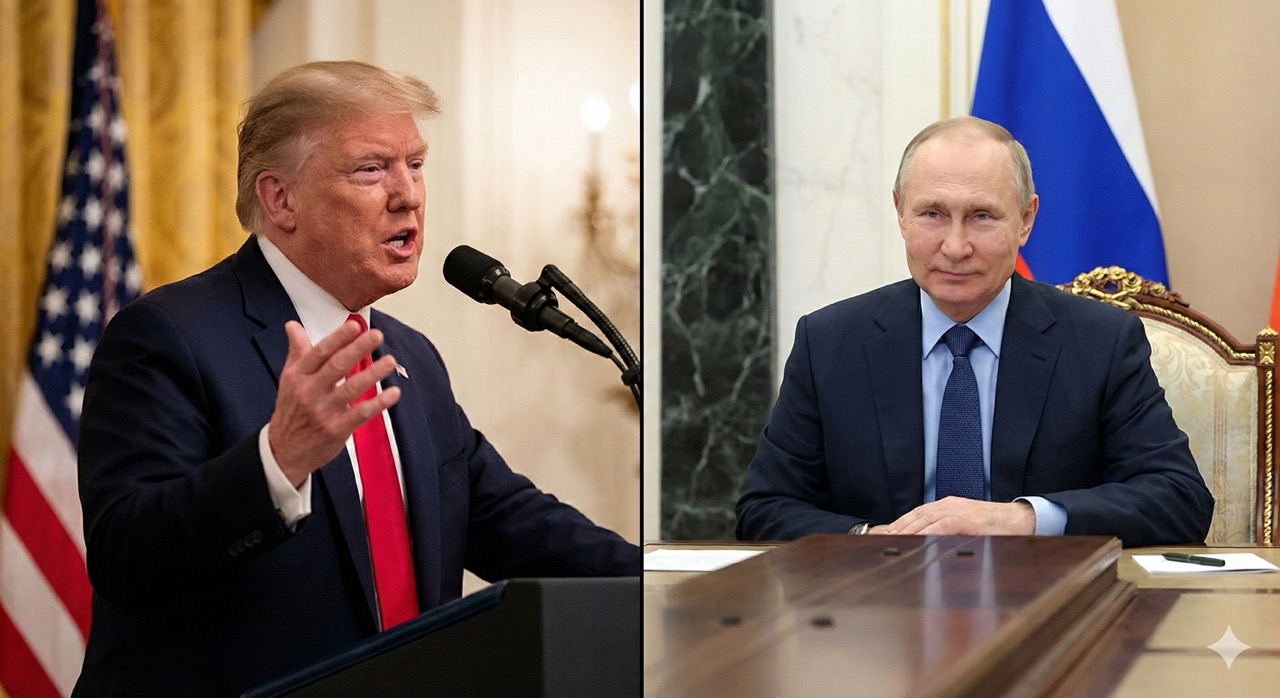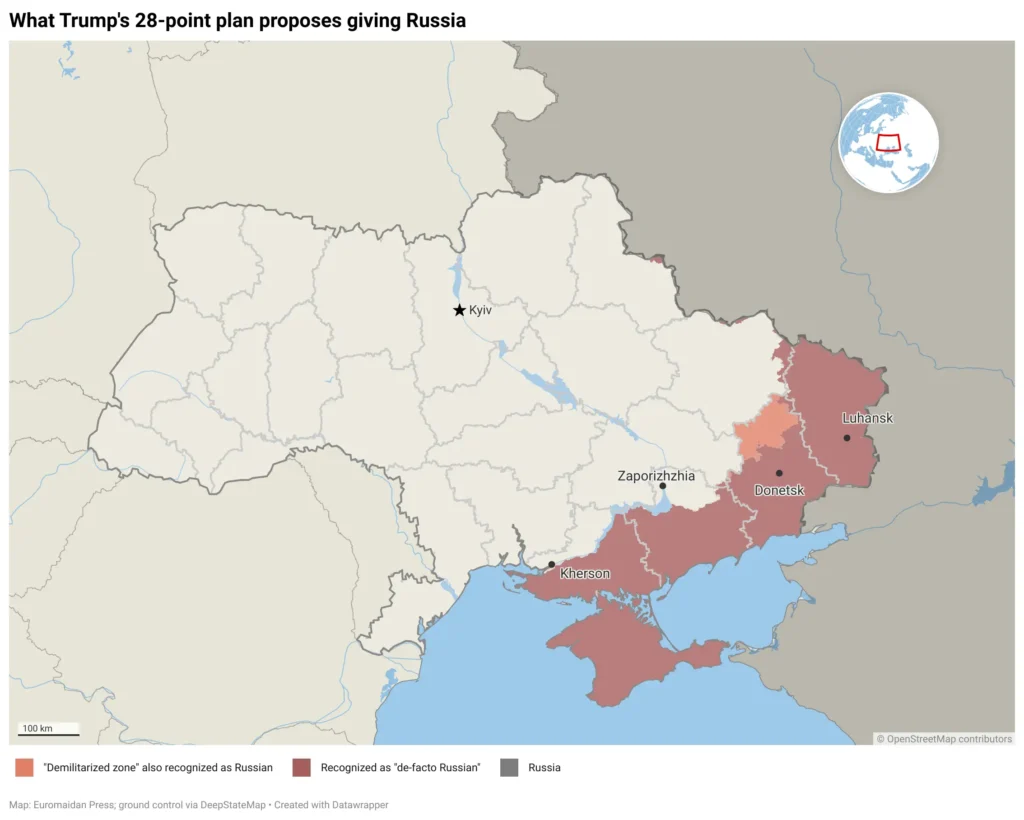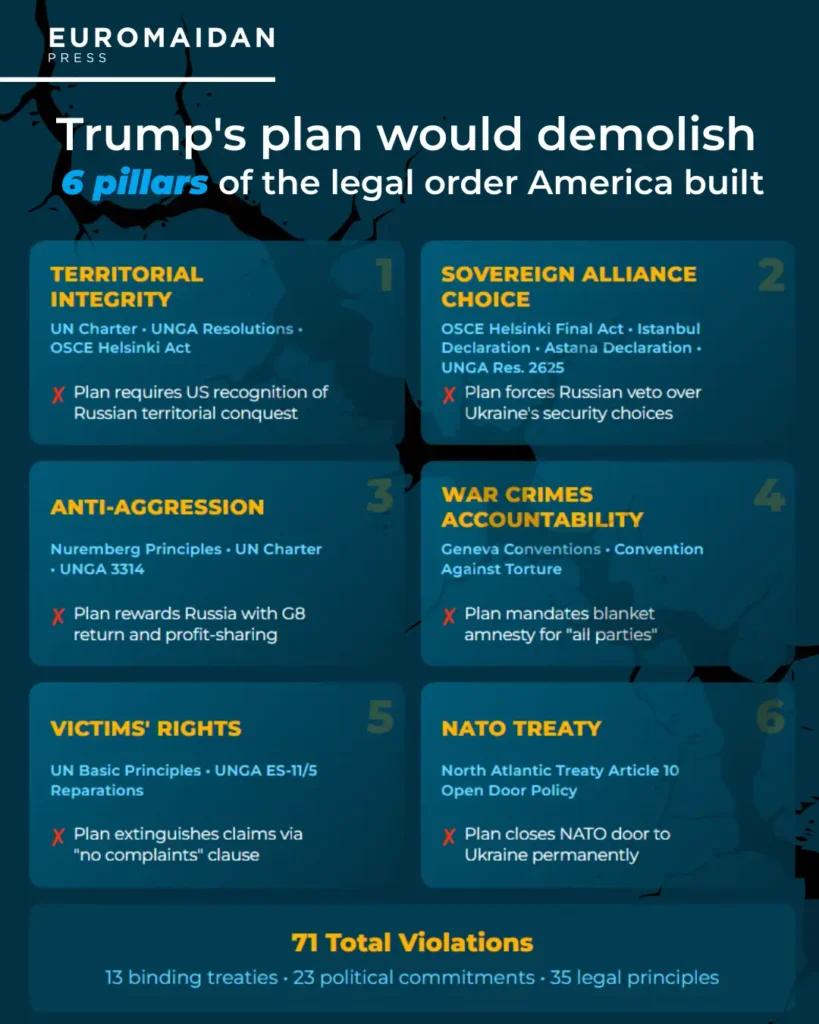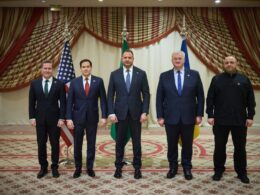A comprehensive legal analysis of the Trump administration's 28-point peace plan for Ukraine reveals that enforcing it would place the United States in violation of 71 separate international legal and political obligations, including 13 binding treaties, 23 political commitments, and 35 explicit articles and legal principles the US is bound by or has endorsed.
The plan, drafted by Trump envoy Steve Witkoff in coordination with Russian presidential adviser Kirill Dmitriev, demands Ukraine cede territory, renounce NATO membership, and accept blanket amnesty for war crimes—all requirements that contradict the very international legal architecture Washington helped build over 80 years.

After three years of grinding losses, Trump’s plan gives Russia terms it couldn’t get in 2022
What the 28-point plan demands from Ukraine
The Witkoff-Dmitriev proposal, reported by Axios and CBS News, requires Ukraine to:
- Recognize Crimea, Luhansk, and Donetsk as "de facto Russian," including by the United States
- Withdraw from currently held territory in Donetsk Oblast, which would then be "internationally recognised as territory belonging to the Russian Federation"
- Freeze Kherson and Zaporizhzhia oblasts along current lines of contact
- Enshrine in its constitution permanent renunciation of NATO membership
- Cap its military at 600,000 personnel (down from current 880,000)
- Accept "full amnesty for all parties involved in this conflict" with "no claims or complaints in the future"
- Agree to NATO's permanent exclusion of Ukraine from membership
In exchange, the plan offers rapid reintegration of Russia into the global economy, including return to the G8, and turns frozen Russian assets partly into a joint US-Russian investment vehicle where "the US will receive 50 percent of the profits."

Six pillars of international law the plan would demolish
There are six clusters of international commitments that the plan contradicts:

1. Non-recognition of territorial acquisition by force
The plan's Point 21 directly contradicts multiple UN General Assembly resolutions the US voted for, including Resolution ES-11/4 (2022), which declared Russian referendums and annexations "invalid" and "illegal under international law" and called on all states not to recognize these territories as part of Russia.
By agreeing to recognize Crimea, Luhansk, and Donetsk as Russian, the US would breach:
- UN Charter Article 2(4): prohibition on threat or use of force against territorial integrity
- UN General Assembly Resolutions 68/262 (2014), ES-11/1 (2022), and ES-11/4 (2022) on Ukraine's territorial integrity
- Declaration on Friendly Relations (1970): no territorial acquisition from force shall be recognized as legal
- OSCE Helsinki Final Act (1975) and Charter of Paris (1990): inviolability of frontiers
- PACE Resolution 2605 (June 2025): territorial acquisitions from force are core violations of the rules-based order
2. Sovereign right to choose alliances
Points 3, 7, and 8 would institutionalize a Russian veto over Ukraine's security choices, contradicting the OSCE acquis that the US helped create. The OSCE Istanbul Summit Declaration (1999) explicitly states: "Each participating State has an equal right to security" and "the right to choose or change its security arrangements, including treaties of alliance," directly rejecting "spheres of influence."
The US would violate:
- UNGA Resolution 2625 (1970): every state has the right to determine its own foreign policy
- OSCE Helsinki Final Act, Charter of Paris, Istanbul Summit Declaration, and Astana Declaration: freedom to choose security arrangements
3. Prohibition of rewarding aggression
Point 13's rapid reintegration of Russia into the global economy and Point 14's profit-sharing from frozen assets would stabilize and legitimize the fruits of what the UN has characterized as aggression, violating the principle that aggression is "the supreme international crime."
This contradicts:
- Nuremberg Charter and Principles: aggression as crime against peace
- ILC Articles on State Responsibility (Arts. 40-41): duty not to recognize or assist serious breaches of peremptory norms
- UNGA Resolution 3314 (Definition of Aggression): no territorial advantage from aggression is lawful
4. Prohibition of amnesty for war crimes
Point 26's blanket amnesty—"All parties involved in this conflict will receive full amnesty for their actions during the war"—would directly violate US treaty obligations to prosecute grave breaches of the Geneva Conventions and torture under the Convention Against Torture.
The US would breach:
- Geneva Conventions (1949): obligation to search for and prosecute grave breaches
- Convention Against Torture (1984): obligation to investigate and prosecute torture
- Customary international humanitarian law: no amnesty permitted for war crimes
- Nuremberg principles: no immunity for officials, war crimes cannot be neutralized by political deals
Follow Euromaidan Press on Google News! Value this reporting? Support our work.
BECOME OUR PATRON!
Trending Now
5. Victims' right to remedy and reparations
Point 26's "no claims or complaints" clause would extinguish victims' rights to justice by political fiat, contradicting the UN Basic Principles on the Right to a Remedy and Reparation (2005) and UNGA Resolution ES-11/5 (2022), which the US voted for, establishing an international mechanism for reparations.
6. The North Atlantic Treaty itself
The plan would force the US to violate the foundational treaty establishing NATO, which the United States serves as depositary for:
- Article 10 (Open Door): NATO membership is open by unanimous agreement; no third state can veto. The plan requires NATO to amend its charter to exclude Ukraine permanently
- Article 1: peaceful settlement and prohibition of force. Supporting a settlement that ratifies gains from aggression contradicts this
- Article 2: strengthening free institutions. Imposing forced constitutional arrangements violates democratic self-determination
Why this legal impossibility matters now
The analysis reveals that the plan isn't merely controversial. It's structurally incompatible with the international legal order the United States created and maintains. Every major category of the plan collides with legal commitments that form the architecture of the rules-based system.
If Washington were to enforce this plan, it would systematically dismantle:
- The post-World War II principle that borders cannot be changed by force
- The OSCE framework that ended the Cold War by guaranteeing states' right to choose their alliances
- The Nuremberg legacy that established accountability for aggression and war crimes
- NATO's open-door policy that has anchored European security for 76 years
The contradictions are fundamental. The plan would require the United States to repudiate the very legal principles it spent eight decades building, voting for in the UN General Assembly, and embedding in treaties it helped draft.

What comes next
The Trump administration has reportedly given Ukraine until November 27 to accept the plan or risk losing American support. Ukrainian President Volodymyr Zelenskyy characterized the choice as "either the loss of dignity, or the risk of losing a key partner."
Canada's Prime Minister Mark Carney stated that while "parts of Trump's plan work," Ottawa is "concerned by the proposed limitations on Ukraine's armed forces, which would leave Ukraine vulnerable to future attack." European leaders are coordinating responses, with the EU pushing back against any deal that doesn't reflect Kyiv's positions.
Russia has rejected the plan despite its favorable terms, with senior Duma member Yevgeny Zhuravlyov dismissing it as a "provocation," insisting only full military victory is acceptable. This suggests the plan may be less a genuine peace proposal than a framework designed to shift blame for continued war onto Ukraine should Kyiv reject it.
It is clear what choosing this path would mean: the United States would trade the rules-based international order it created for a transactional deal that legitimizes conquest, rewards aggression, and establishes precedents that would echo across every territorial dispute globally.

Trump-backed peace plan lands in Kyiv, testing Ukraine’s resolve amid war and corruption scandal
Follow Euromaidan Press on Google News! Value this reporting? Support our work.
BECOME OUR PATRON!





